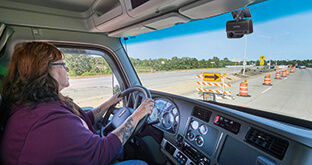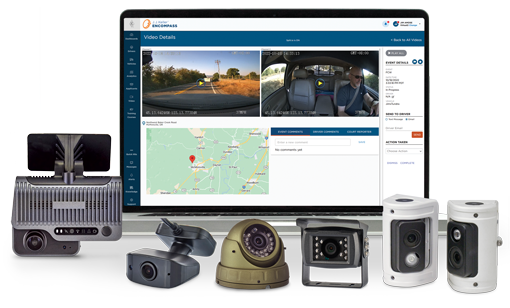Sr. Transportation Management Editor — J. J. Keller & Associates, Inc.
The Game Changer — Using Dash Cams to Coach Drivers
Driver coaching is the foundation of any top-tier performance management program. Here are four aspects of successful driver coaching.
Published On: 09/01/2024
This article was originally published in 2021, and updated in 2024.


Written by:
Mark Schedler
The continual coaching and correction of unsafe behavior, particularly from driver-specific dash cam video footage, minimizes the potential for negligent supervision and maximizes your return on investment in proactive safety systems. Coaching is the foundation of any top-tier performance management program — no matter what size fleet you have.
A driver coach’s purpose is more than highlighting performance or skill gaps. A coach's primary responsibility is to motivate a driver to become more safe and productive with a balance of constructive feedback and recognition. A coach should also be able to make tough disciplinary decisions.
There are four aspects of driver coaching that are essential for success:
- Coach selection, development, and measurement
- Tips to increase driver acceptance of cameras and coaching
- Five stages of a successful coaching session
- Coaching documentation
The Coaches
SELECTION
Limit coach selection to a select group of individuals who can be objective and have the right skills. If the number of coaches gets too large, the quality and consistency of feedback may suffer. Note that a coaching mentality sustains behavioral and cultural change when it’s ongoing and relies on rapport-building skills. Conversely, a “gotcha” mentality won’t be well-received by drivers and does not encourage improvement.
DEVELOPMENT
Don’t underestimate the importance of developing coaches or assume certain people do not need training just because they seem like natural coaches. You may find that a few of your star leaders are not great coaches and may be surprised by others who demonstrate a knack for building rapport and getting drivers to take accountability — without putting them on the defensive. Remember, the tone of coaching sessions will be shared among drivers quickly. One poorly executed session can create a negative ripple effect.
MEASUREMENT
Don’t leave the coaches out of the measurement process. A little healthy competition between coaches can add motivation to do well. Give ongoing feedback to keep your coaches sharp and consider incorporating relevant metrics. Possible metrics include:
- Coaching Timeliness - the percentage of events coached within a specific timeframe of the driving event, such as within two to three days.
- Coaching Efficacy - the percentage of similar risk events by driver/by coach within a specified timeframe.
- Anonymous driver evaluation of the coaches.
Regardless, you should see visible evidence of a coach’s commitment to improving their ability to affect change in others.
BEST PRACTICES FOR PREPARING COACHES
- Have coaches assess several of the same video events to verify the consistency of assessments between coaches. Not every clip or piece of data will be a coachable event.
- Use role-play exercises to ensure coaches build rapport and trust and provide counsel without putting drivers on the defensive.
Driver Acceptance
Driver performance monitoring with cameras can create a mindset for some drivers that “big brother is watching.” You must overcome that belief to be successful.
Drivers should care about the feedback coaches provide, in the same way that an athlete who receives feedback on their on-field performance. Video clips are like game film, and telematics data are the driver’s game statistics. Helping the driver become a better performer ensures employability and compensation for them and improves your bottom line.
TIPS FOR INCREASING DRIVER BUY-IN OF DASH CAM SYSTEMS
- Test dash cams with a small group of drivers.
- Share the test-group results in “town hall.” Allow open-forum discussions to dispel rumors and address concerns.
- Emphasize that video is used to coach, improve, and keep drivers — not weed out “bad” drivers.
- Stress the potential benefit of driver exoneration in case of their involvement in a crash.
- Consider a non-punitive break-in period with no disciplinary penalties unless a safety situation calls for action.
- Train drivers thoroughly on the system triggers and the feedback process.
- Consider a signed agreement saying that drivers’ privacy will be protected.
- Start with event-based, road-facing cameras versus continuous monitoring with road- and driver-facing cameras.
- Ensure coaches acknowledge the challenges drivers face and use videos for recognition as well as constructive feedback.
- Integrate video system event metrics into the driver bonus program.
Successful Coaching Sessions
Coaching sessions must be timely, conducted in private, and provide a safe environment for drivers to share their feedback. How coaches prepare for the meetings, approach the drivers, and gain commitment to behavior change is equally important. Below are the five stages of a successful coaching session:
1. Scheduling: Coach in a timely manner per the company standard. And verify that the driver will be available, rested, and receptive to the timing of the session.
2. Preparing: Focus on the facts, avoid emotions, and don't make assumptions. Review the driver’s history for trends and analyze the video at least twice and get another coaches opinion, if needed. Also, think through the conversation and write down key points.
3. Building Rapport: Greet the driver in a positive manner and treat them with respect. Ask how their day is going. Tell them that you appreciate their time and recognize a positive safety history when appropriate.
4. Coaching and/or Recognition:
- Have the driver review the video clip before discussing what you think happened.
- Ask the driver whether there are other factors that aren't evident from the video, including what happened during his or her day leading up to the event.
- Ask the driver how they would correct the root cause.
- Cover any points the driver missed and note positive behavior along with areas that need improvement. Explain the risk of continuing unsafe behavior.
- Be consistent with disciplinary actions as outlined in your company's policies. If the driver deflects the conversation to something off topic or reacts defensively, respectfully guide them back to the reason for the session.
- Document the root cause and next steps.
5. Gaining Commitment: Get a commitment from the driver to correct unsafe behaviors and engage in safe behavior in the future, not just agree to complete the follow up actions.
End the session on a positive note by thanking the driver and letting him or her know that you are available anytime and that they are a valuable member of the safety team.
Coaching Documentation
You do not want to keep corrective action information beyond your document retention policy for disciplinary documents. If you put a driver on a 90-day action plan based on following-too-close events and the driver has avoided following-too-close events for 90 days, follow your company document retention and corrective action policies. If your policy states, “keep everything for employment plus three years,” then adhere to that.
If you have the policy to destroy disciplinary documents one year after the behavior is corrected, that is what you should consistently do for every driver. However, never destroy or try to conceal any information once a major accident has occurred, as you could easily be found to have engaged in “spoliation” or destruction of evidence.
To learn more about how to leverage dash cams and data effectively, download a copy of J. J. Keller’s The Fleet Manager’s Playbook — Using Driver Data for a Safe and Productive Fleet. This 38-page guide will help you develop critical dash cam program elements and best practices to mitigate risk, create effective policies and procedures, assist in evaluating and choosing metrics, and how to use data to incentivize and recognize drivers.
You may also enjoy the following articles:
Sign up for our newsletter!
We'll help you stay on top of regulations, best practices, and fleet industry news. Sign up to receive a monthly email notification with links to our most recent blog articles, free resources, and event invites.
